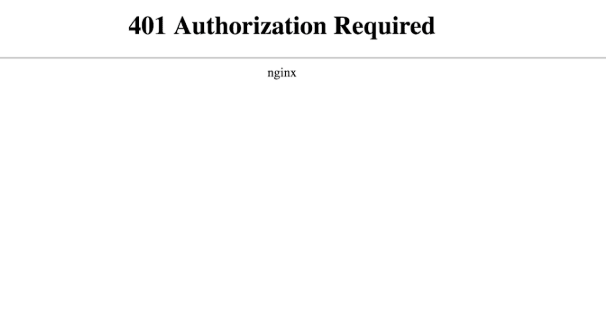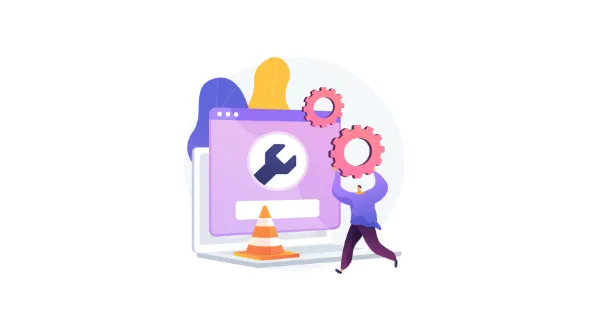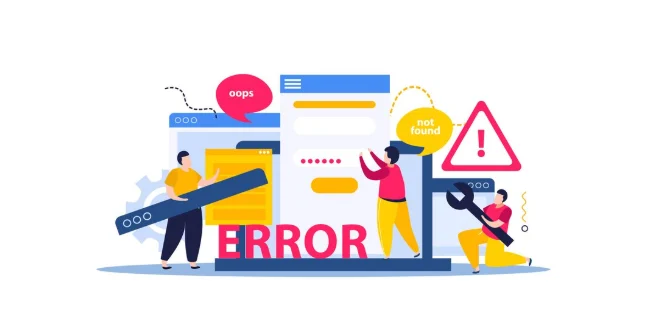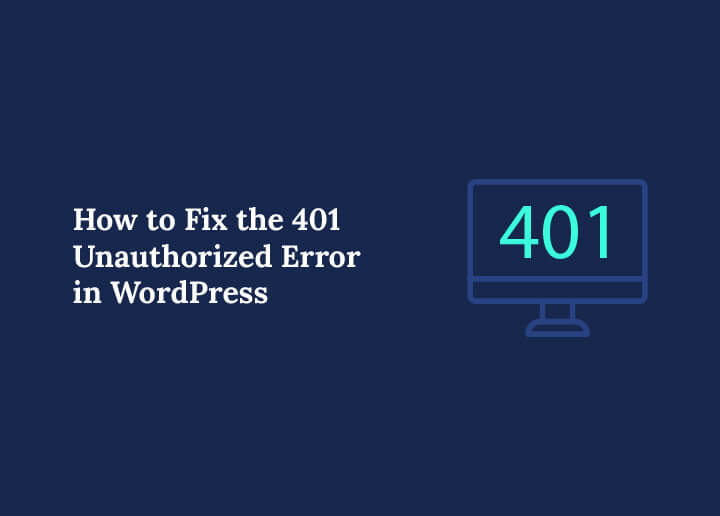Encountering a 401 Unauthorized error in WordPress can be frustrating, especially when it prevents you or your visitors from accessing your website. This error typically shows up when the server cannot verify that the request lacks valid authentication credentials.
In simpler terms, it means something is wrong with the login or authentication process.
For website owners, this error not only affects functionality but can also impact user experience, SEO performance, and trust in your brand. The good news? You can fix it.
In this guide, we’ll explore why the 401 error happens, how to diagnose the root cause, and provide simple solutions to resolve the issue fast.
What is the 401 Unauthorized Error?
The 401 Unauthorized Error is an HTTP status code. It signals that the server received the request but refused to authorize it due to missing or incorrect credentials. This can occur on login pages, admin panels, or even when accessing protected content.

You might see this error as:
- “401 Unauthorized”
- “HTTP Error 401”
- “Authorization Required”
The appearance may vary depending on your browser or WordPress configuration, but the cause is generally the same: authentication failure.
Read: Common WordPress Errors And How To Fix Them
Why Does the 401 Unauthorized Error Occur in WordPress?
There are several reasons why this error might pop up:
- Incorrect login credentials leading to authentication process failed error message
- Plugin conflicts on the web page, especially security plugins
- Password-protected page or directories requiring user permissions or valid credentials
- Browser caching issues
- Outdated browser cache
- Outdated cookies or DNS records
- Faulty .htaccess file on WordPress website
- Server misconfigurations by WordPress hosting provider
Knowing what causes the error is the first step to resolving it. Now, let’s walk through how to fix each potential issue.
Learn more: How to Fix the 500 Internal Server Error in WordPress
How Proactive Maintenance Plans Can Help Prevent These WordPress Errors?
Keeping your WordPress site healthy goes beyond fixing problems when they arise. That’s where proactive maintenance plans come in. These structured routines are designed to identify and prevent issues, like the 401 Unauthorized Error, before they disrupt your site.

By staying ahead of problems, you not only reduce downtime but also improve security, performance, and user experience. Below are key components of proactive maintenance that directly help prevent such WordPress errors:
Regular Software Updates
Keeping your WordPress core, themes, and plugins updated ensures compatibility and reduces security vulnerabilities. Outdated code can trigger authentication failures and cause 401 errors. As such, scheduled updates reduce the risk of plugin or theme conflicts that often lead to login issues.
Routine Security Scans
Running regular malware scans and vulnerability checks helps catch threats before they impact access or login functionality. Many 401 errors stem from unauthorized attempts and security plugin conflicts; routine scans can prevent these. Proactive detection also allows you to act before your login systems are compromised.
Scheduled Cloud Backups
Automatic backups protect your site from data loss and give you the ability to restore a working version if errors occur. You can roll back quickly if a 401 error appears after a misconfiguration. Maintenance plans also ensure backups are performed consistently without manual effort.
Performance Optimization
Fast, optimized sites are less prone to cache-related errors and timeouts that can trigger access issues. Regular cache clearing, database optimization, and CDN tuning can prevent server-related 401 errors. Website maintenance plans can often include tools to automate this process.
User Role and Permission Audits
Reviewing user access levels helps prevent unauthorized access and incorrect credentials. Many 401 errors are caused by permission mismatches or unauthorized login attempts. Proactive site audits can catch issues before they lock out legitimate users.
Plugin and Theme Conflict Testing
Testing updates on a staging site helps you identify and resolve plugin or theme conflicts before applying changes to the live site. This minimizes the risk of a plugin update triggering a login error. WordPress site maintenance plans often include staging environments to safely test changes.
Know more: Preventative vs Reactive Maintenance of Your Website
Activity and Error Log Monitoring
Monitoring login attempts, failed authentications, and server errors provides early warnings. Tools like WP Activity Log let you spot suspicious behavior that may lead to 401 errors. Maintenance teams can act on those logs to prevent recurring issues.
DNS and Web Hosting Environment Checks
Regular DNS checks and server maintenance ensure that configurations are stable and up-to-date. Misconfigured DNS settings or outdated SSL certificates can cause 401 errors. Proactive maintenance includes reviewing these settings periodically.
By integrating these elements into a well-structured maintenance plan, you can prevent the most common WordPress errors, including the frustrating 401 Unauthorized Error, before they ever occur. It’s a smart, cost-effective way to maintain site health and provide a seamless experience for your users.
Keep Your WordPress Site Error-Free and Secure
Don’t wait for WordPress errors to disrupt your site. Let us handle the updates, backups, security checks, and performance optimization.
Fix the 401 Unauthorized Error in WordPress: Simple Solutions
Here are some simple and advanced solutions that you can follow to rectify the 401 error in WordPress:
Solution 1: Clear Browser Cache and Cookies
Outdated cache and cookies can store old login data, leading to failed authentication attempts. Here’s how to clear cache and cookies:
- Open your browser settings
- Navigate to Privacy and Security
- Choose clear browsing data
- Select Cookies and Cached Files
- Click Clear Data
After doing this, refresh your WordPress login page. If the error persists, try the next method.
Guide to: How to Clear WordPress Cache
Solution 2: Disable Password Protection on Directories
If your site or specific directories are password-protected (via .htpasswd or cPanel settings), this can trigger the 401 error when credentials don’t match. To disable it:
- Log in to your cPanel
- Go to Directory Privacy or Password-Protected Directories
- Locate your site’s root or wp-admin folder
- Remove the password protection temporarily
- Test your site access
If the error disappears, the issue was due to incorrect or outdated credentials.
Related: Malware Removal Services Vs Website Security Services
Solution 3: Deactivate All WordPress Plugins
Conflicts caused by security or login-related plugins are a common cause of this error. So, start by deactivating plugins via the dashboard:
- Go to Plugins ⟶ Installed Plugins
- Select all, then choose Deactivate from the bulk actions dropdown
If you can’t access the dashboard:
- Use FTP or File Manager in cPanel
- Navigate to
/wp-content/ - Rename the plugins folder to plugins-old
Now, refresh your site. If it loads properly, rename the folder back and reactivate plugins one by one to find the culprit.
Solution 4: Switch to a Default WordPress Theme
Sometimes, themes (especially custom or outdated ones) can interfere with login functions. To switch to a default WordPress theme:
- Go to Appearance ⟶ Themes
- Activate a default theme like Twenty Twenty-Four
- If you can’t access your dashboard, rename your active theme’s folder via FTP to force WordPress to revert to a default theme.
If the 401 error resolves, your theme may have an authentication conflict or outdated code.
Solution 5: Flush DNS Cache
Corrupted or outdated DNS records can cause access issues, including the 401 error. To flush DNS, follow these steps.
For Windows: Open the command prompt.
Type ipconfig /flushdns
And press Enter
For macOS: Open the terminal
Type sudo dscacheutil -flushcache; sudo killall -HUP mDNSResponder
Enter your password
This will remove cached DNS records and can fix server communication issues.
Solution 6: Check Response Headers
Your browser’s developer tools can give insights into what’s happening during the request. To access it:
- Open your site in the browser
- Right-click and choose Inspect
- Go to the Network tab
- Reload the page and look for failed requests
- Click the failed request and check the Headers tab
Look for entries like WWW-Authenticate, Authorization, or any unusual redirects. This can help pinpoint the error source.
Solution 7: Verify Authentication Credentials
Incorrect login details are one of the most obvious but overlooked causes of this error. To verify it:
- Double-check your WordPress admin credentials
- If you’ve forgotten them, reset via email or phpMyAdmin
- Also, check if your API keys (for third-party services) are still valid
If you’re using basic authentication, ensure your .htaccess and .htpasswd files are correctly configured.
Solution 8: Use Secure Authentication Methods
For added security and fewer login issues, use modern protocols like:
- OAuth
- JWT (JSON Web Tokens)
- Two-Factor Authentication (2FA)
These methods reduce the chances of server-side rejections caused by outdated or insecure login systems.
Plugins like WP OAuth Server, JWT Authentication for WP REST API, or Wordfence Login Security are great choices to get started.
Solution 9: Test the Site in Different Browsers
Sometimes, the error is browser-specific. Try accessing your WordPress site from:
- Google Chrome
- Mozilla Firefox
- Safari
- Microsoft Edge
Also, check if browser extensions (like ad blockers or privacy tools) are interfering. Use Incognito or Private Mode to rule out extension-related issues.
Solution 10: Reset WordPress Passwords
If your user roles or password data are corrupted, resetting passwords can help. You can do this via the dashboard:
- Go to Users ⟶ All Users
- Select your account
- Click Generate Password
Or via phpMyAdmin:
- Access your WordPress database
- Open the wp_users table
- Edit your user row
- Replace the user_pass field with a new password (hashed using MD5)
Solution 11: Restore .htaccess File
A corrupted or misconfigured .htaccess file can block access and trigger the 401 error. To fix this:
- Use FTP or File Manager
- Rename .htaccess to .htaccess_old
- Go to your WordPress dashboard (if accessible) and visit:
- Settings ⟶ Permalinks ⟶ Save Changes
This will generate a fresh .htaccess file with default rules.
Know about: How to Fix Err_SSL_Protocol_Error
Best Practices to Prevent Future 401 Errors
Once you’ve resolved the 401 Unauthorized Error, the next step is prevention. Implementing the right practices can minimize this recurring issue and help keep your WordPress site secure and accessible. Here are some simple but effective tips:

Use Secure Authentication Protocols
Modern authentication methods add an extra layer of security. Protocols like OAuth and JWT (JSON Web Tokens) allow for token-based authentication and reduce dependency on traditional username/password combinations.
Additionally, enabling Two-Factor Authentication (2FA) ensures that even if login credentials are compromised, unauthorized access is still blocked. Recommended plugins are:
- WP OAuth Server
- JWT Authentication for WP REST API
- Wordfence Login Security
Regularly Update WordPress, Plugins, and Themes
Outdated core files, plugins, or themes can introduce vulnerabilities and conflicts that trigger authentication errors. So, set a schedule to update everything to their latest versions regularly. Also, always test major updates on a staging site before going live.
Pro tip: Enable auto-updates for trusted plugins and themes when available.
Clear Browser Cache and Cookies Frequently
Old or corrupted cache and cookies can interfere with login sessions and trigger errors. Make it a habit to clear browser data periodically, especially if you notice access issues. Encourage users and site admins to do the same.
Avoid Using Too Many Security Plugins
WordPress security plugins are essential, but too many can conflict with one another, leading to authentication problems. Choose one or two well-reviewed security plugins that cover your needs without overlapping features. Popular options include:
- SolidWP
- Wordfence Security
- Sucuri Security
Backup Your Site Regularly
Regular backups ensure that you can restore your site quickly without losing data, even if something goes wrong. Schedule automatic daily or weekly backups depending on how often your site is updated. Trusted backup plugins and tools are UpdraftPlus and BlogVault.
Monitor Login Activity
Tracking login attempts helps detect suspicious behavior early. Plugins like WP Activity Log give you real-time insights into user activity, failed login attempts, and potential brute-force attacks. This helps you take preventive action before minor issues become major problems.
By applying these best practices, you can reduce the risk of 401 errors and create a more secure, stable experience for your WordPress users and admins alike.
Easy Guide: How to Fix CORS Error in WordPress
Conclusion
The 401 Unauthorized Error in WordPress might seem intimidating at first, but it’s usually easy to fix once you identify the cause. Whether it’s a cache issue, plugin conflict, or incorrect credentials, each of the solutions listed here will guide you toward resolution.
Start with the basics; clear your browser cache, verify your login details, and disable plugins. Then, move on to advanced checks like flushing DNS, testing different browsers, or checking your .htaccess file.
With regular maintenance and a few preventative steps, you can avoid this error altogether and ensure smooth access for you and your visitors.
Remember: every website faces issues from time to time. The key is knowing how to respond and now, you do.
FAQs About 401 Errors
How to quickly fix the 401 Unauthorized Error?
To fix the 401 Unauthorized Error quickly, clear your browser’s cache and cookies, and try logging in again. If the issue persists, disable all your plugins from the admin dashboard or via cPanel, and switch to a default theme to rule out conflicts.
What is 401 Authorization Required in WordPress?
The “401 Authorization Required” message means the server is rejecting your login request due to invalid or missing credentials. It can also occur if your site is password protected at the server level or if authentication headers are misconfigured.
How to get rid of 401 Unauthorized?
You can resolve this error by:
- Checking and correcting your login credentials
- Clearing browser cache, cookies, and DNS cache
- Disabling all plugins and switching to a default theme
- Ensuring your URL is correct and not restricted by server rules
Also, check the WWW-Authenticate header in the developer console for clues.
How to fix 401 Unauthorized-Access is denied due to invalid credentials?
This error means your login attempt failed. Fix it by:
- Verifying your username and password
- Removing any password-protected directories from your hosting account via cPanel
- Flushing your DNS cache and clearing site data
- Reviewing the response headers in the developer console for authentication issues
Try accessing the site from a different browser to rule out browser-related problems.



